Who: Preschool and elementary ages
What: Illustrate and write captions for a Book of the Bible
When: During family devotions
When I had little people to teach about Jesus, I read the Bible with my girls. For the projects shown here, I read a chapter aloud each morning. The girls chose something from the chapter to illustrate, and wrote a caption to summarize their drawing. We accomplished three goals with this simple project: hearing God's Word, practicing drawing skills, and writing brief summaries.
Note: I didn't mandate the cover drawings. One certain someone liberally borrowed her older sisters' ideas, much to their annoyance.
 Pages from a 6th grader's Fashion Chic magazine Who: Any age What: "Publish" a magazine about a topic/theme of the student's choice How:Collect a variety of magazines for your students to browse, or look through the magazine collection at your local library.List the types of pieces included in the magazines.Invite students to brainstorm possible themes for their own magazines (e.g. sports, fashion, animals, adventure, current events, history). The assignment (to be modified to your situation)- Write and revise at least five substantial* pieces: articles, advice column, interview, etc.
- Make at least four miscellaneous pieces: puzzles, advertisements, comic strips, etc.
- Make a cover and a Table of Contents.
- Put it all together in an attractive presentation.
*You can define substantial for your students. Set a deadline. (Remember that too little time may result in rushed products, but too much time may encourage procrastination.) Ask students to write a proposal for you, their publisher. With their best writing, they need to explain their vision for the magazine. Possible content to include:- An explanation of the topic/theme and why they chose it
- A brief overview of the pieces they plan to write
- A brief overview of the extras they will include
- A plan for how they will budget their time to meet the deadline
- An explanation of how they hope their completed magazine will look
As the publisher, you need to approve the proposal or return it for further work.Set aside time each day for researching, planning, writing, revising, and laying out the magazine. To help students stay on target, consider giving them a chart for setting goals and recording completed work. Magazines may be bound in regular binders or taken to an office supply store for coil or spiral binding.Please send me pictures! I want to see the results. : )
Year ago I offered a class in my home. The objective for the students was simple: to write a variety of pieces to include in a coilbound book. The students included a cover, Table of Contents, dedication, and About the Author. Simple but effective. Your students can make their own books, too. Maybe they have ten (or so) pieces scattered on notebook paper. Have them walk through the writing process for each one, moving the pieces from rough to polished. Or maybe you're at a loss for what should go in the book. If that's the case, browse through the ideas in Inspiration. Choose assignments that will interest your students and get them writing. Details to Consider:- Because these are polished pieces, they need titles.
- Typing the pieces will make the books look crisp and finished.
- You will have a sturdier book if you print the text on cardstock.
- Illustrations would add a nice touch.
- I highly recommend the extras: the cover, Table of Contents, dedication, and About the Author.
- Binding is available at office supply stores. It's fast and it's cheap.
Once the books are ready, set them on the coffee table where family and visitors can page through them. Don't be surprised if you find the authors looking through them as well. They'll be that proud!
When I mentored a young history buff this past summer, I asked her to choose a person or event to study. She chose Helen Keller. I brainstormed fun and challenging writing assignments for her, which I now share with you! Use the ideas as stand-alone assignments or in a project. Project Ideas:- Make a blank book with Keller as the subject.
- Display the assignments in a portfolder with various flaps and folds.
- Print each piece on cardstock and compile the collection in a book with coil binding, comb binding, strip binding, or book-style binding, available at office supply stores.
- If you have multiple students completing the assignments, make a book (similar to the previous idea) with chapters. Students can brainstorm creative titles for each section.
Do a KWL chart. Set aside time (one hour?) when you’re doing something with others—playing with friends or sisters, helping Mom in the kitchen—to be deaf, blind, and mute (any or all). Write about your experience. Read about one of Helen’s many temper tantrums. Write about the incident, once from Helen’s point-of-view, once from Annie’s. "Interview" Annie or Helen. What lessons can we learn from Helen’s life? Write a paper with an engaging lead and a satisfying conclusion. What word best describes Helen? Write a paragraph with several examples. Write a poem about Helen and/or Annie. Find some structures here. Write a scene based on the picture below. Be sure to answer who, what, when, where, why, and how. Include the senses. 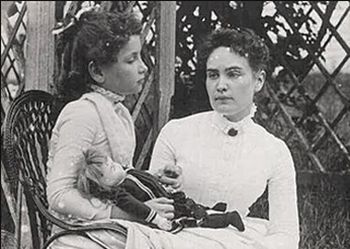 ~Helen Keller & Annie Sullivan - July, 1888~ Photo courtesy of Wikipedia Write a quote from Keller's autobiography in braille. Your own ideas (I never assume my ideas are the only or best ones. Getting you out of the gate is my goal.)
Who: Elementary and middle school students, although adaptations can be made for younger students
What: Write a biographical picture book, using the format modeled by Jacqueline Briggs Martin in Snowflake Bentley.
How: - Notice how Martin includes interesting information about Bentley in the story and in the sidebars.
- Choose a person who intrigues or inspires you.
- Find books, websites, and/or articles about the person.
- Read. Read. Read.
- Use a graphic organizer (like the first page of this one) to help you gather important information. Add any other categories you like. To avoid plagiarizing someone else's work, write your notes after the resources have been set aside.
- Instead of writing a report about the person, write a story as Martin did. If there is anything in Martin's writing that you want to imitate, like her beginning, that's okay. Just use your own words.
- Remember, writing is a process. A draft is the beginning, not the end. Ask someone--or two someones--to read your draft, ask questions about it, and make helpful comments, all to aid you in making your story better.
- Break the story into chunks suitable for a picture book.
- For a handful of pages, write a sentence or two for sidebars that give additional information about your person. Notice the page in Snowflake Bentley that says, "He could pick apple blossoms and take them to his mother. But he could not share snowflakes because he could not save them." On the right is related information about Willie and his mother that Briggs chose to share there rather than in the story.
- Present your story in a blank book or any other way you like. (I'd love to see a copy in the Student Showcase.)
We've made photobooks online to document a vacation or a school year, but I never thought of using them for writing and illustrating a book. Look at one blogger's idea here.
If your elementary-aged students are ready to write a research report, here are two resources to help them.
| Just the Facts walks students through a basic overview of each of the tools they will use in their report, from starting with a topic to making a bibliography. | Don't Be a Copycat! is intended for the older elementary crowd, its content going deeper, including more detailed information about plagiarizing, assessing sources, taking notes, and citing sources. As the title indicates, the goal is to teach students how to avoid plagiarism.
| Writing a research report need not be daunting. With their step-by-step instructions and conversational tone, both of these books will ground your children for the challenge before them.
When my oldest daughter was little, her aunt gave her a butterfly garden. What a delight for her (and me) to watch the process of metamorphosis! Of course, even though she was five, I couldn't let the writing opportunity pass us by! I asked her to keep a record of her observations which then went into a book she illustrated. This assignment worked so well that I did it with my other daughters when they were old enough to make their own books. Who: preschool and elementary-aged children What: To connect writing with science, students watch the process of metamorphosis, keeping a record of their observations and making a simple book. Excerpts from Janessa's dictated text:
April 13
When we came home from church, my mom noticed that there were two cocoons on the lid, and me and my sisters were really excited because we knew they would be coming out soon.
April 15
Today there was a problem. One caterpillar on the bottom was very confused about where to make his cocoon. But there was another problem. It wasn't that he was on the bottom; it was that his cocoon didn't have the color it should. It was green.
April 22
Today one of my butterflies has a broken wing. My mom, my sisters, and I were all sorry for my little butterfly. I was about to cry when my mom noticed it because I didn't want my little tiny butterfly to be dead.
Today one of the cocoons dropped from the lid and went under the grass, so my mom, my sisters, and I couldn't see him. And he changed under the grass so we wouldn't see him so he would have privacy. The entries were good practice with non-fiction writing, but with interest in the butterflies high, I also asked them to write a fiction piece, a short story about a caterpillar-turned-butterfly.
Michaiah's story:
Once there was a caterpillar named Katie. One day she decided to make a cocoon and she took a hammer and nails and began hammering the nails around herself. Then she stayed there for sixteen days and on the seventeenth day she decided to try to get out of the cocoon. Then she nibbled and nibbled but she could not get out. So she hollered for help but no one came so she kept hollering for help but still no one heard her. Finally, she gave up and wiggled so much that the cocoon fell and broke a hole in it. Then she got out and was a beautiful butterfly. The End.
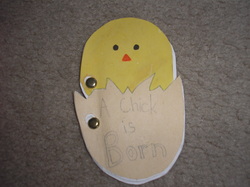 A Related Idea
My husband said he knew we were homeschoolers when we incubated chicks in the dining room of our townhouse. That incredible process was also recounted in a small book, this time with transitional words (i.e. then, next, now) instead of dates.
A Related Story
We also watched tadpoles become frogs. Seemingly not keen on his home, one jumped out and landed behind the faucet of our kitchen sink, his transformation halted. (Uh, he died.) Not finding a single man in the neighborhood to remove him, I scraped and flipped him to the first place I could think of: the disposal. I dropped some other scraps down there and flicked the switch, trying hard not to think about what was happening. We didn't have any related writing projects! : )
Our kids know how to e-mail, chat, and text. Do they know how to write a personal letter? Last year, I gave my eighth graders regular opportunities to write letters by pairing them with senior citizens they had never met. Their assignment was to write monthly to their new friend, asking questions, answering questions, and developing a relationship. At the end of the year, when all those goals were accomplished, they used the research they gleaned from the letters and wrote a biography of their pen pal. They then adapted their paper into a speech, which they presented to the pen pals at their first face-to-face meeting.
Of all the assignments and projects they completed during the year, this was by far the most successful, establishing enduring relationships and giving students a real reason for writing and public speaking.
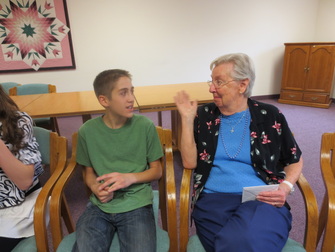 Micah and Arlene 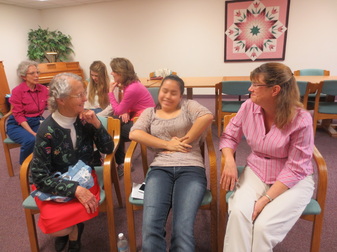 Rosie and Rosie (and Rosie's mom) 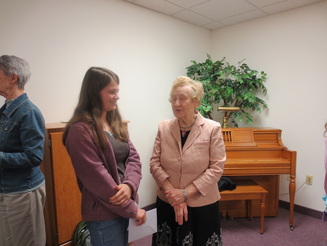 Leah and Dot  Ethel and Lianna (and Lianna's mom)  Sara and Jonas 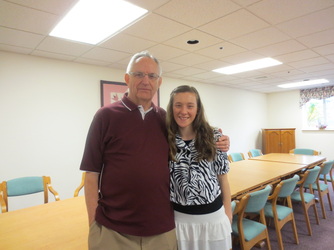 David and Alyssa--This was the only sad part of the project. Alyssa's pen pal was David's wife Joyce until she suddenly passed away.
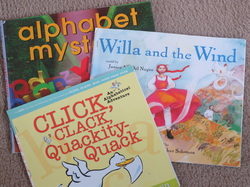 You know you're not supposed to judge a book by its cover, but these covers do not contain what you may suppose. You likely assume that the authors of these books are Doreen Cronin, Janice M. Del Negro, and Audrey Wood. If so, you are wrong. In fact, the authors are my daughters.
The local library had a crate of extra book jackets to give away, so I took a pile of them. The girls each chose their favorite one; then, using clues from the title and cover illustration, they wrote their own stories.
To make these books a little sturdier, we glued pieces of cardstock inside the front and back covers; we also printed their stories on cardstock. To hold it all together, we anchored the pages by stapling along the left side.
After they were finished, we found the original stories to read and compare.
This simple idea inspires creativity while giving kids a starting point, taking away the dread of filling a blank piece of paper, leaving them with real writing they will be eager to share.
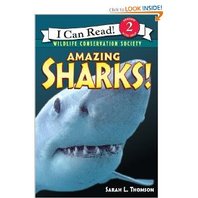 Not into fiction? Find a jacket for a non-fiction book. I tutored a boy who would rather trap and skin mice than read or write. He chose the Amazing Sharks! book cover, researched his favorite sharks, wrote a paragraph about each one, and drew simple illustrations to go with his text. It still wasn't as riveting as playing with mice, but at least he could accomplish his mom's goals while studying nature, his other passion.
|
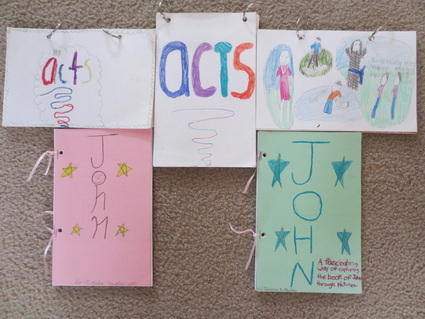

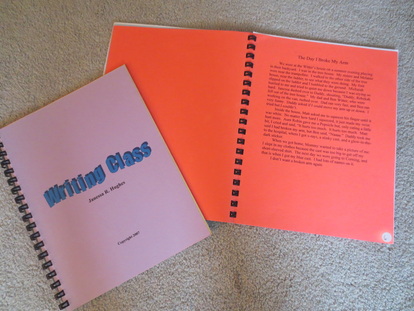







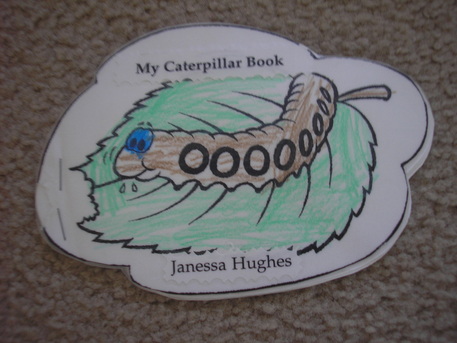
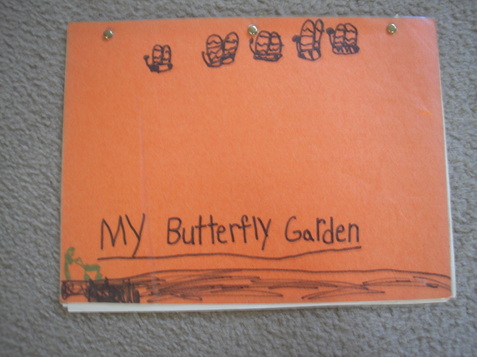

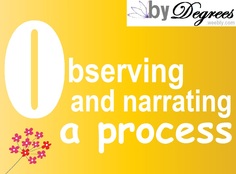











 RSS Feed
RSS Feed